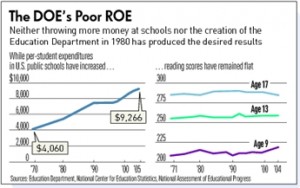Money For Nothing- More Union Payoffs with YOUR Money
Posted 02/10/2010 07:08 PM via IBD
 Schools: The Education Department is getting one of its largest spending increases under the president’s proposed budget. And what can the country expect in return for all this added spending? Not much.
Schools: The Education Department is getting one of its largest spending increases under the president’s proposed budget. And what can the country expect in return for all this added spending? Not much.
The White House’s fiscal 2011 budget includes a 10% hike in discretionary spending for the Education Department. Education Secretary Arne Duncan says “It’s one of the largest increases ever proposed,” which is saying a lot for a department that is accustomed to spending more of other people’s money every year and will spend $77 billion next year if Congress complies with the president’s request.
At a briefing last week, Duncan noted that “the proposed budget,” which is exempt from the administration’s spending freeze, “also reflects the president’s broader commitment to efficiency, cutting red tape and holding ourselves accountable for results.”
Sounds like a promise that the taxpayers will be getting something back for the billions the bureaucrats will be spending.
But it’s a promise that won’t be kept.
History shows us that spending increases do not equate with improved results. Though there are a lot of problems in America’s public school system, a lack of funding is not one of them.
The Heritage Foundation says that since 1985, five years after the Education Department was established, “inflation-adjusted federal spending on K-12 education has increased 138%.” Yet during that time, enough time for bright minds to put a lot of money to use, “indicators of educational improvement such as increases in academic achievement and graduation rates have remained flat.”
For instance, in the 1990-91 school year, the graduation rate was 73.7%. It crept up to 74.7% in 2004-05 before slipping to 73.4% the next year.
Reading scores have also stagnated. Rather than increasing as spending has increased, they have gone sideways for a quarter of a century. (See chart.)
Math scores on the SAT have gone nowhere. In 1966-67, the mean for that section was 516. In 2007-08 it was 515.
American kids are not even making great strides in geography. In 1994, the fourth-grade average was 206. Seven years later, it was 209. Over that same period, eighth-graders went from 260 to 262 and high school seniors haven’t been able to move from 285.
Meanwhile, science scores for eighth-graders fell from 148 in 1996 to 147 in 2005, though fourth-grade scores rose from 145 in 2000 to 149 five years later.
Yearly spending on public education, including state and local dollars, on grades kindergarten through 12 is now well beyond a half-trillion dollars. That’s a big chunk of the economy. For that amount of money, our kids should be getting far better educations.
But Washington’s spending habits are based on politics, not results, and the White House’s proposed education spending hike has the rancid smell of a political payoff.
Almost every dollar — 95% — of the $5.4 million that the teachers’ unions gave in the 2008 election cycle went to Democrats. Unlike taxpayers who get a miserable return on their “investment” in public education, unionized teachers get results when they spend.
Help Make A Difference By Sharing These Articles On Facebook, Twitter And Elsewhere:
